• Non-Stick
The 5 Best and Safest Cookware Choices for Your Health

Reviewed by Trinity Anderson
Last Updated January 2024
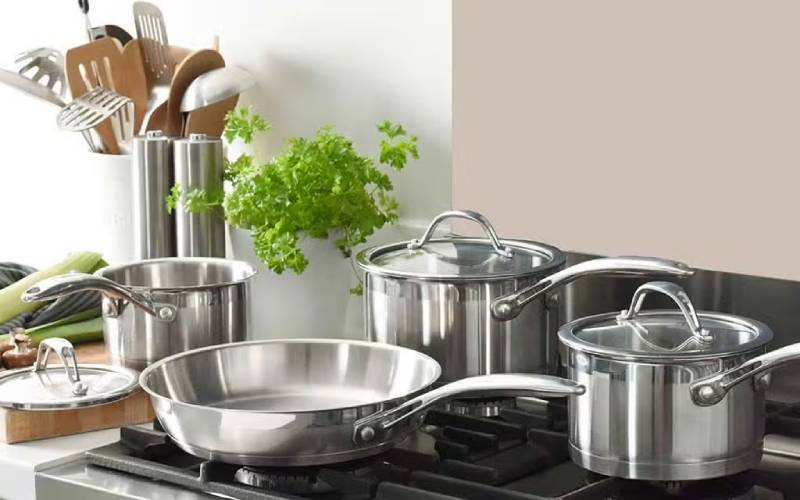
Here’s why choosing the safest cookware is so important.
When it comes to selecting food, your dietary choices have a direct impact on your overall well-being. The food you consume has a significant influence on your health, and the cookware you utilize also plays a crucial role in this relationship.
To illustrate this point, let's imagine a scenario where a buttered slice of bread accidentally falls onto a carpet, landing butter-side down. If you were to simply pick up the bread and eat it, you would inadvertently consume any particles that have adhered to it. Similarly, the cookware you use can have an effect on the food you prepare.
The process of cooking involves an interaction between the materials used in your cookware and the ingredients you cook with. Therefore, it is essential to make a well-informed decision when choosing cookware that is safe for your health. It is important to note that not all cookware is created equal.
For instance, non-stick cookware coated with PTFE (also known as Teflon) can release fumes that are irritating to humans and can be fatal to pet birds. Additionally, PTFE can flake off at high temperatures, posing potential health risks.
Uncoated aluminum cookware has the potential to leach into your food, especially when cooking acidic foods such as tomatoes. This can result in the ingestion of aluminum, which may have adverse effects on your health.
Similarly, unlined copper cookware can also leach metal into your food, potentially reaching unsafe levels for consumption.
It appears that finding the perfect cookware option for your home is quite challenging. However, the question remains: what is the safest cookware for your health?
To provide you with a solution, we have conducted thorough research and have simplified the decision-making process by outlining the advantages and disadvantages of each type of cookware below. Additionally, we have curated a selection of the best cookware options in each category to assist you in making an informed choice.
Top 5 safest and healthiest cookware choices:
Safest Cookware Option 1: 100% Ceramic
Ceramic is a type of non-metallic, inorganic material that is formed by baking clay at high temperatures. This process results in a hard and corrosion-resistant material. Once glazed, ceramics are baked again to create a surface that is impermeable to water and is considered one of the safest options for cookware in terms of food contact.
Advantages:
1. It does not contain any metals that can leach into food.
2. It is made without the use of PTFE, perfluorooctanoic acid (PFOA), and other harmful chemicals commonly found in non-stick cookware.
3. The glazing on ceramics is naturally non-stick, making it easy to clean. It is also baked on, eliminating the risk of flaking, scratching, or peeling off. Additionally, it has an aesthetically pleasing appearance.
4. It is safe to use in microwaves and can be completely recycled.
5. Ceramic is non-reactive with acidic foods, preserving the flavor and quality of the food.
6. It can withstand high temperatures, making it suitable for slow cooking and oven use.
7. The handles of ceramic cookware are molded, eliminating the need for handle rivets or screws that may loosen over time.
Disadvantages:
1. Ceramic cookware can be more expensive compared to traditional metal cookware.
2. It retains heat, so it is necessary to use potholders or oven mitts when handling it. The handles also remain hot for a period of time after cooking.
3. Ceramic cookware can crack or shatter when exposed to sudden temperature changes, such as placing a hot pan into cool water for washing. It can also break if dropped on a hard surface or subjected to heavy force.
Best Choice for 100% Ceramic Cookware
Xtrema Pure Ceramic Cookware
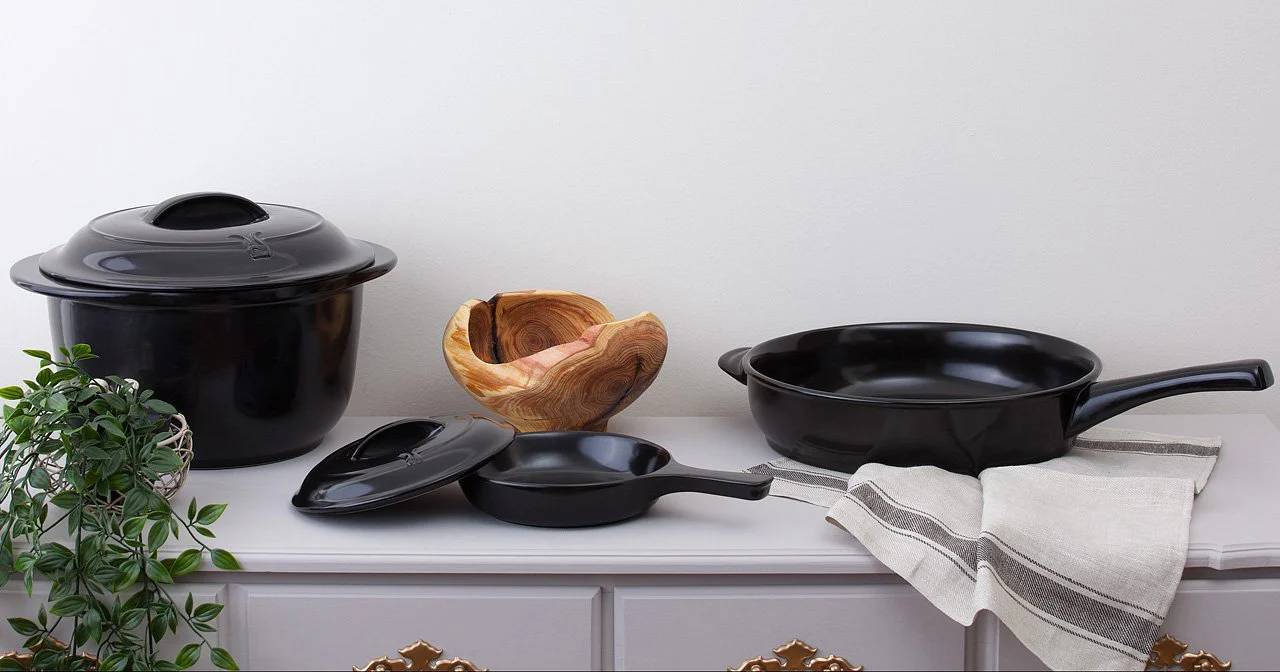
Xtrema cookware is a remarkable choice for those seeking a truly pure and safe cooking experience. Unlike other cookware options, Xtrema is crafted from 100% pure ceramic, ensuring that no harmful substances such as PTFE, PFOA, glues, polymers, coatings, dyes, or any other chemicals are present. This commitment to health and safety is further reinforced by its FDA approval and compliance with California Prop 65 standards, which guarantees the absence of over 900 chemicals known to cause cancer, birth defects, or reproductive harm.
One of the standout features of Xtrema cookware is its ability to preserve the natural flavors and health benefits of your food. With no metals that can leach into your meals, you can rest assured that your dishes will maintain their original taste and nutritional value. Moreover, Xtrema prioritizes transparency by subjecting every shipment to rigorous inspections and tests for heavy metals. If desired, you can even request a copy of the latest report to ensure the utmost peace of mind.
In addition to its health-conscious attributes, Xtrema cookware is also environmentally friendly. It is crafted from renewable materials and manufactured using methods that are gentle on the earth. Versatile in its usage, this cookware can be safely utilized on stovetops, ovens, microwaves, and BBQ grills. While it does require delicate handling due to its fragility, we, at the Cookware Advisor, firmly believe that the extra care is worth it, as Xtrema stands as the epitome of safety in cookware.
Safest Cookware Option 2: Ceramic-Coated Cookware
Ceramic-coated cookware refers to metallic cookware, such as aluminum or stainless steel, that has been coated with a non-stick ceramic coating. This is different from regular non-stick cookware, which usually has a PTFE (Teflon) type plastic coating. The ceramic coating is made from inorganic minerals, mainly silicon and oxygen, and is applied to the metal using a wet chemical technique called sol-gel technology. It may also contain binders, color pigments, and reinforcing agents.
Advantages:
1. The coatings used on non-stick cookware are completely free of PTFE, PFOA, and other chemicals.
2. These coatings are resistant to scratches and abrasion, making them long-lasting.
3. They can withstand higher temperatures compared to chemical-based non-stick coatings.
4. The coatings are non-reactive to acidic foods, ensuring the taste and quality of your dishes.
5. Only a small amount of butter or oil is required for cooking, reducing fat consumption.
6. The even heat transfer of these coatings results in lower power consumption while cooking.
7. They are lightweight and easy to clean, making your cooking experience hassle-free.
8. You can choose from a wide range of vibrant colors to match your kitchen decor.
Disadvantages:
1. Ceramic coatings can be expensive, making them less accessible for some consumers.
2. Heat distribution may be uneven in some cases, affecting the cooking process.
3. Hybrid ceramic coatings may contain some PTFE, compromising their complete chemical-free nature.
4. These coatings are vulnerable to cracking and chipping, especially when exposed to metal utensils or sudden temperature changes.
5. The non-stick life of a ceramic coated pan is generally shorter compared to a PTFE coated pan.
6. It is generally not recommended to use ceramic coated cookware under a broiler or in dishwashers, as detergents can wear out the non-stick surface.
Best choices for Ceramic-Coated Cookware
Option 1
Ceramic coated aluminum cookware: Caraway Cookware
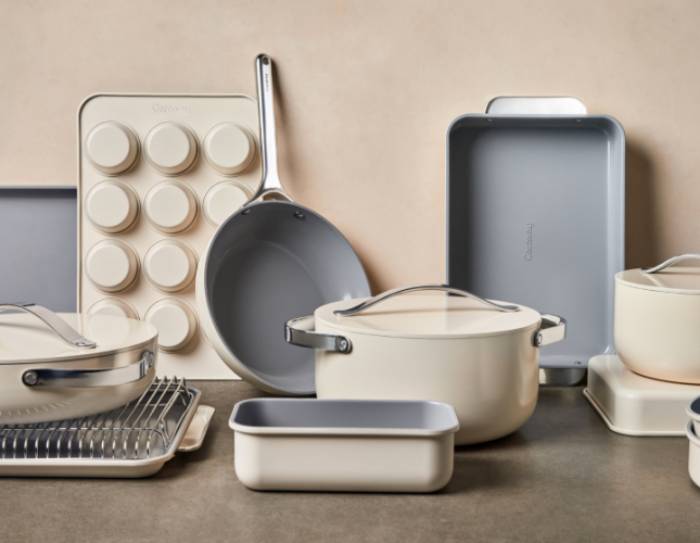
Caraway ceramic-coated cookware is renowned for its commitment to ethics and safety. Crafted from heavy gauge aluminum, it features a mineral-based coating that is both non-toxic and free from harmful substances like lead, cadmium, and PTFE. With its non-stick surface, cooking with Caraway requires minimal butter or oil, ensuring healthier meals. Cleaning up is a breeze, and the vibrant color options add a touch of elegance to any kitchen.
What sets Caraway apart is its dedication to the environment. The manufacturing process of Caraway cookware emits significantly less carbon dioxide (CO2) into the atmosphere, reducing its environmental impact by up to 60%. Additionally, the cookware is packaged in recycled cardboard, eliminating the use of plastic bags. The packaging also utilizes low-impact print dyes, further minimizing its ecological footprint. To top it off, Caraway includes 100% biodegradable cork trivets, showcasing their commitment to sustainability.
Option 2
Ceramic coated stainless steel cookware: GreenPan cookware
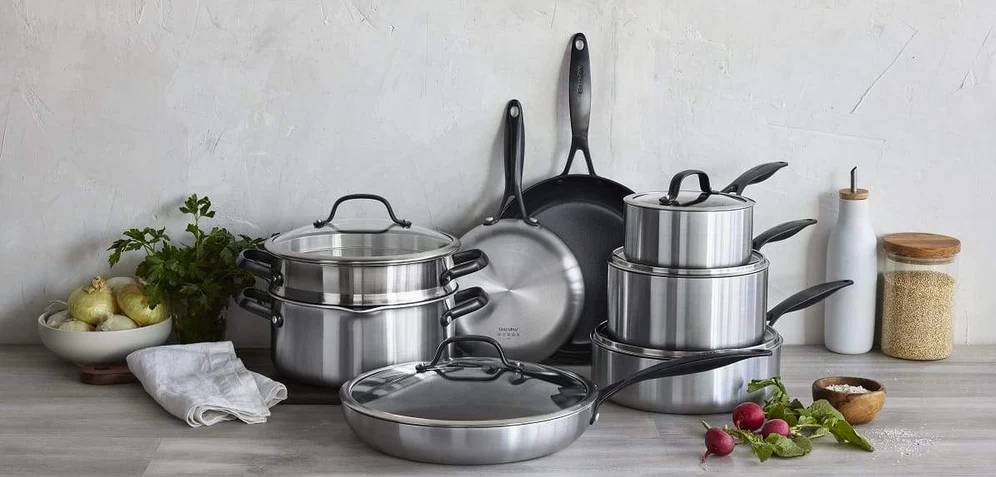
GreenPan revolutionized the cookware industry by introducing ceramic coated non-stick pans as a healthier alternative to teflon. Their extensive product range includes saucepans, woks, and more, all crafted from durable hard anodized aluminum or tri-ply stainless steel. The non-stick coating, Thermolon, is a ceramic-based formula that is free from harmful substances like PTFE, PFOA, lead, and cadmium.
With its scratch-resistant properties, GreenPan cookware ensures quick and even heating on any stovetop. Thanks to Magneto induction technology, which utilizes locked-in ferromagnetic particles, the cookware remains resistant to deformation while promoting efficient oil or butter distribution for consistent cooking results.
The non-stick surface of GreenPan cookware allows for effortless food release and easy cleanup. No more scrubbing is required! Simply wipe the pan clean with a soft cloth and soapy water.
As an environmentally conscious company, GreenPan takes pride in using upcycled stainless steel and aluminum whenever possible. Similar to Caraway, they strive to reduce their carbon footprint by emitting up to 60% less CO2 during the manufacturing process. These sustainable practices have earned GreenPan numerous ISO certificates, recognizing their commitment to quality management and environmentally friendly production methods.
Safest Cookware Option 3: Stainless Steel Cookware
Stainless steel is a term used to describe a range of different steels known as alloys. These alloys are created by combining two or more metallic elements to enhance the strength and resistance against corrosion of the metal.
Primarily composed of iron and carbon, stainless steel earns its reputation for being stainless due to the addition of chromium. Chromium forms a protective layer of chromium oxide on the steel's surface, which prevents corrosion. In order to meet the standards set by NSF International for food contact, food-grade stainless steel must contain a minimum of 16% chromium. Other elements such as nickel, nitrogen, manganese, titanium, and molybdenum are often added in varying quantities to enhance the strength and corrosion resistance of the steel.
How can you determine the quality of stainless steel?
According to NSF standards, stainless steel used for food equipment must belong to the AISI 200, 300, or 400 series.
Here's what each series signifies:
200 Series
Manufacturers replace nickel with manganese in this series, making it more affordable. However, stainless steel from the 200 series is not of high quality, making it susceptible to corrosion and unsuitable for induction stovetops.
300 Series
The 300 series is the most commonly used stainless steel in cookware and includes two popular categories: 304 and 316.
The 304 series utilizes 18/10 and 18/8 stainless steel. The first number represents the percentage of chromium (18%), while the second number indicates the amount of nickel (10% and 8%). Stainless steel from the 304 series is non-magnetic and non-reactive.
The 316 series (less common) is a higher-end version of stainless steel that contains a small percentage of molybdenum. This addition makes it more resistant to corrosion but also more expensive.
There is little disparity in everyday functionality between the two options.
400 Series
Primarily utilized for flatware, mixing bowls, and inexpensive crockpots, 400 series stainless steel comprises 18% chromium and no nickel. Although the 400 series is magnetic, it is not as corrosion-resistant as the 300 series and gradually loses its luster.
In general, stainless steel is not an exceptional conductor of heat. To enhance conductivity, stainless steel cookware often incorporates a core of aluminum or copper (usually in the form of a disc at the base of the pan).
Advantages:
1. Affordable and easy to clean, making it a cost-effective option.
2. Durable and long-lasting, with a sleek and polished appearance that complements any interior design.
3. Highly resistant to acidic foods, ensuring that it remains in good condition even when cooking with such ingredients.
4. Scratch-resistant and safe for use with metal utensils, providing peace of mind during cooking.
5. Low maintenance and lightweight, allowing for effortless handling and convenience.
6. Capable of withstanding high temperatures without encountering significant issues.
7. Environmentally friendly as it is 100% recyclable.
8. Widely regarded as one of the safest materials for cookware.
Disadvantages:
1. Not non-stick, requiring the use of more oil or butter compared to non-stick cookware. Additionally, pre-soaking may be necessary for cleaning.
2. Heat distribution may be uneven depending on the thickness of the aluminum or copper core.
3. Magnetic stainless steel is required for compatibility with induction cooktops.
4. There is a possibility of chromium leaching into food, which may cause allergic reactions despite being a naturally occurring essential nutrient.
5. Small amounts of nickel may also leach into food, especially when the steel has been scratched or subjected to abrasive scouring. While health agencies state that this poses no significant health risk, individuals with nickel sensitivities may experience allergic reactions.
Best Choice for Stainless Steel Cookware
Made In Cookware
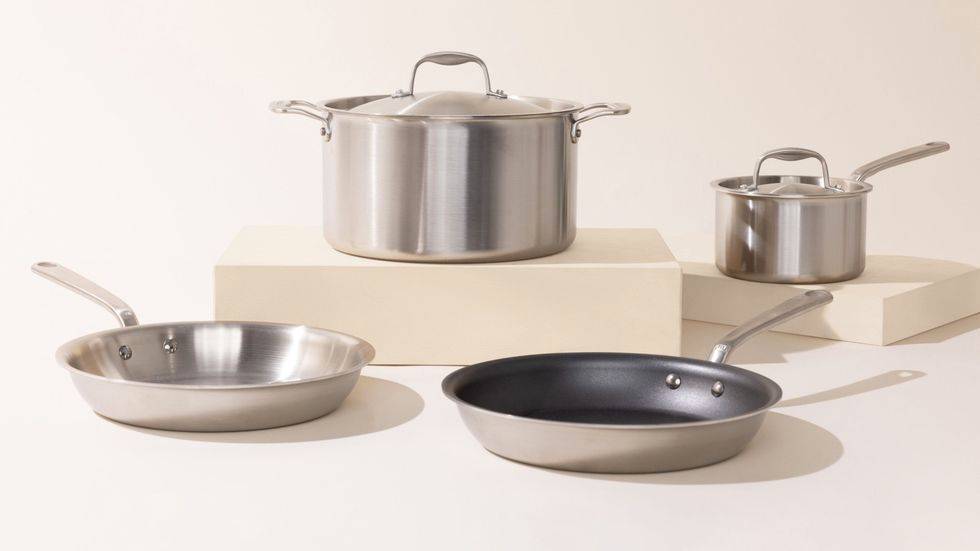
Made In Cookware is my top recommendation for stainless steel cookware due to its exceptional quality and affordability. This cookware is proudly made in America and offers a 5-ply construction, meaning it consists of five layers of metal. The three layers of heavy-gauge aluminum are sandwiched between inner and outer layers of stainless steel. This unique construction ensures excellent heat conduction, retention, and distribution, eliminating any hot spots.
The inner layer of Made In cookware, which comes into contact with food, is made of 18/10 304 series stainless steel. The outer layer features a stylish brushed-steel finish and is made of magnetic 403 stainless steel. This magnetic property allows all Made In pans to be used on induction cooktops, making them versatile and convenient.
In addition to its superior performance, Made In cookware boasts a well-balanced heft that is lighter and easier to control compared to heavier cast iron cookware. The longer-than-normal handles are riveted on for durability and help to keep the handles cool while cooking.
Furthermore, Made In cookware is safe to use in the oven and under broilers. It is also dishwasher-safe, although as the Cookware Advisor, I always recommend hand-washing for optimal care and longevity. For a more detailed review, please read my full review here.
Safest Cookware Option 4: Nickel-Free Stainless Steel Cookware
Nickel-free stainless steel, known as JYH21CT, is a type of Japanese 21/0 steel from the 400 series. It contains 21% chromium, 0% nickel, low levels of carbon and nitrogen, and does not include molybdenum. Referred to as SUS443J1 according to Japanese Industrial Standards, this type of stainless steel may contain small amounts of titanium or copper to enhance its resistance to corrosion and heat conduction. Moreover, it is considered to be environmentally friendly.
It is widely acknowledged that regular stainless steel cookware can release trace amounts of nickel and chromium into food. While this is generally not a concern for most individuals, it can pose a problem for those with a nickel allergy, which affects approximately 15-20% of the population. Consequently, the popularity of nickel-free stainless steel cookware has significantly increased as a suitable option for individuals seeking cookware that is free from nickel. (To explore more options for nickel-free and safe cookware, please refer to my article on the top 7 choices for nickel-free cookware.)
Advantages:
1. An excellent option for individuals with nickel allergies.
2. Offers comparable corrosion resistance to 304 stainless steel.
3. Lightweight and effortless to manage.
4. Efficiently conducts heat, reducing energy consumption during cooking, and can withstand high temperatures.
5. Possesses good magnetic permeability, making it ideal for induction cooktops.
6. Durable and resilient, with a polished finish that enhances the appearance of any kitchen.
7.Generally affordable and easy to clean, with high resistance to acidic foods.
Disadvantages:
1.Similar to stainless steel in general, cookware without nickel requires some practice to prevent food from sticking to the pans.
Best Choice for Nickel-Free Stainless Steel Cookware
Homi Chef Nickel Free Stainless Steel Cookware
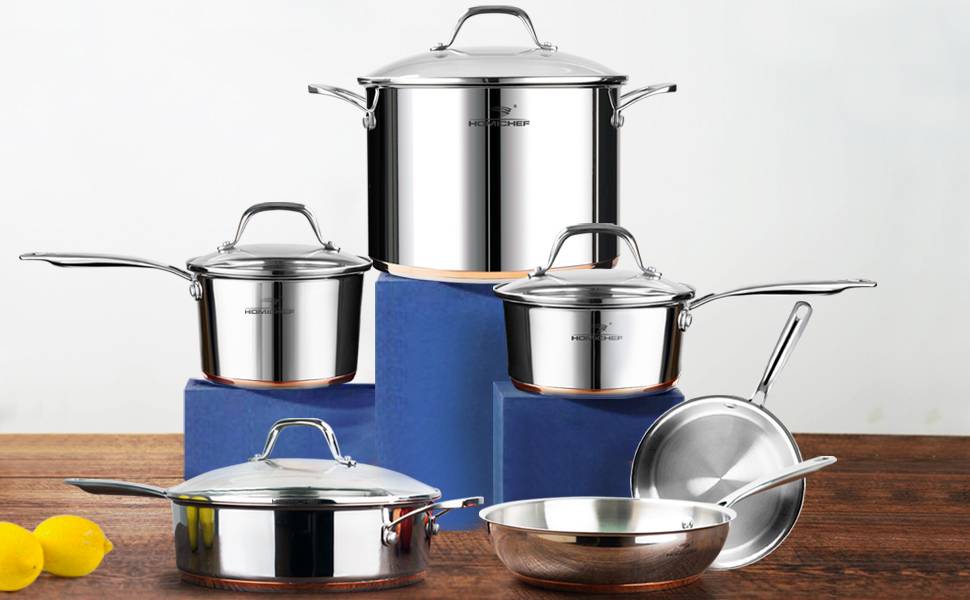
Homi Chef presents a remarkable collection of cookware made from 3-ply stainless steel, featuring a layer of pure aluminum encased between inner and outer layers of nickel-free 21/0 stainless steel. This unique construction ensures efficient heat conduction and distribution, eliminating any chances of uneven heating. Consequently, your food is less likely to stick or burn.
In addition to its exceptional performance, Homi Chef cookware boasts ergonomic handles that remain cool during cooking, offering a comfortable and secure grip. Furthermore, the inclusion of see-through tempered glass lids allows for easy monitoring of your culinary creations, ensuring optimal results every time.
Not only is this cookware a culinary delight, but it is also highly practical. It is dishwasher and oven safe, and compatible with all cooktops, including electric, gas, and induction. With Homi Chef, you can enjoy the perfect blend of functionality and convenience in your kitchen.
Safest Cookware Option 5: Cast Iron Cookware
Cast iron is a type of alloy that is created by melting iron in a foundry and mixing it with steel, carbon, and other elements. This mixture is then poured into sand molds to create various cooking utensils such as fry pans, Dutch ovens, griddles, saucepans, and more.
The raw form of cast iron is highly susceptible to corrosion. To prevent this, it needs to be seasoned, which involves baking oil or fat into the metal. However, some cast iron cookware, like Le Creuset, comes with a porcelain enamel coating that prevents corrosion and eliminates the need for seasoning.
One important thing to note about cast iron is that it can react with acidic foods and release iron into the food. While small amounts of iron can be beneficial for health, excessive amounts can cause stomach pain, nausea, and other gastrointestinal issues. The amount of iron that leaches into food depends on various factors such as the type of food, cooking duration, and water content. However, well-seasoned cast iron cookware has been found to leach negligible amounts of iron into food, according to recent studies conducted by America's Test Kitchen.
In conclusion, cast iron is generally considered a safe option for cookware.
Advantages:
1. Enhances iron intake in the diet.
2. Does not contain chemical-based coatings that can release harmful substances into food.
3. Highly durable and can withstand the use of steel utensils, lasting for generations.
4. Typically made as a single piece of metal, eliminating the risk of loose handle rivets.
5. Provides non-stick cooking and easy cleanup when properly seasoned.
6. Excellent heat retention, making it ideal for slow-cooked dishes like stews.
7. Can withstand high temperatures, making it suitable for various cooking methods and stovetops.
Disadvantages:
1. Can be expensive.
2. Enameled cast iron may chip if mishandled or exposed to extreme temperatures or cold water.
3. Requires regular seasoning, which can be time-consuming.
4. Improper seasoning can cause food to stick.
5. Requires frequent reseasoning.
6. Heavy to handle and handles can become hot enough to cause burns.
7. Takes longer to heat up, may heat unevenly, and retains heat even after the heating element is turned off.
8. Not dishwasher safe, and scouring or washing can damage the seasoning easily.
Best Choice for Cast Iron Cookware
Lodge Cast Iron
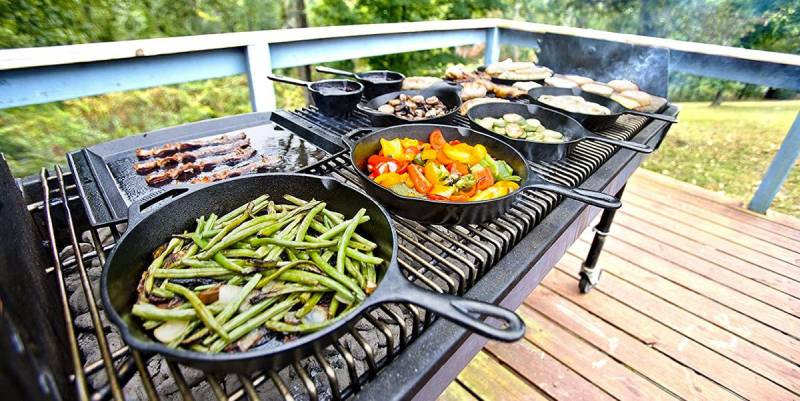
Lodge cookware has a rich history of producing cast iron pieces for more than a century. They take great pride in the quality of their products, which are built to last for generations. The durability and longevity of their cookware is truly unmatched, especially considering the affordable price at which it is offered. Lodge describes their cookware as incredibly tough, capable of withstanding decades of use in the kitchen.
In addition to their traditional cast iron line, Lodge introduced a seasoned cast iron collection in 2002. This innovative line involves baking soybean oil into the cookware at high temperatures, resulting in a surface that is easy to release food from and ready to use right away.
Lodge goes beyond just offering cookware. They also provide a range of options such as enameled cookware, cast iron and glass lids, and unique cooking accessories like grill presses and panini presses made from seasoned cast iron. Furthermore, they offer silicon and leather pan holders to ensure the safety of your hands while cooking.
Lodge's commitment to the environment is commendable. They use recycled steel in their cookware and have implemented various eco-friendly initiatives. As a zero hazardous waste foundry, Lodge utilizes biodegradable and recyclable packing materials, reuses sand molds, and employs equipment that minimizes energy consumption. Additionally, they responsibly treat wastewater by feeding it into ponds that support fish, plants, and wildlife.
Overall, Lodge cookware is not only known for its exceptional quality and durability, but also for its dedication to sustainability and environmental responsibility.
Which cookware is right for you?
Determining the safest cookware can be a daunting task. To simplify your decision-making process, we have identified the top 5 safest cookware brands, including 100% ceramic, ceramic-coated aluminum/stainless steel, stainless steel, nickel-free stainless steel, and cast iron. Within each category, we have also highlighted the best recommended options.
However, with so many choices available, it can still be overwhelming. To assist you in selecting the safest cookware set for your health, here are seven fundamental factors to consider:
1. Budget: It is advisable to invest in the highest quality cookware that fits within your budget. Remember, you will be using it for years to come. For instance, if you opt for stainless steel, choose the best quality available.
2. Material: Prioritize cookware that conducts heat efficiently, distributes heat evenly, and is non-reactive or minimally reactive with food.
3. Your Cooking Personality: Consider your cooking preferences and style. If you enjoy gourmet cooking or require quick meal preparation, select cookware that aligns with your needs. Stainless steel and cast iron are excellent choices for gourmet chefs, while ceramic-coated cookware may be more suitable for those seeking convenience.
4. The Foods You Make: Take into account the types of dishes you frequently prepare. Stainless steel is ideal for stir fry dishes, while cast iron is well-suited for searing. While there may not be a single pan that covers all your cooking needs, you can prioritize the ones that will be most versatile for your culinary endeavors.
5. Number of People You Cook For: If you regularly cook for a large family, it may be necessary to invest in a comprehensive range of cookware. However, if you primarily cook for yourself or a small number of individuals, a few essential pieces may suffice.
6. The Stove You Use: Cookware made from any material is suitable for electric, gas, or ceramic cooktops. However, only certain materials are compatible with induction cooktops.
7. Things to Avoid: Steer clear of stainless steel cookware without an aluminum or copper core for efficient heat conduction. Additionally, avoid uncoated aluminum and inexpensive non-stick pans with coatings that tend to flake off.
By considering these factors, you can make an informed decision and select the safest cookware set that meets your specific requirements.
First and foremost, avoid succumbing to the pressure of purchasing a cookware set that includes more pieces than you actually require. The most suitable and secure cookware set for you might consist of individual pieces carefully selected to cater to your specific needs, lifestyle, and health objectives.